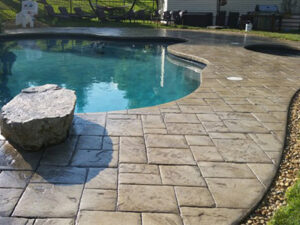A well-designed pool deck can enhance the overall enjoyment factor of your swimming pool. Whether you choose to build a simple deck with a railing or a complex deck with a staircase, you should keep an open mind and avoid limiting your options by material or design. It is best to hire Concrete Contractors who can guide you and strike the perfect balance between aesthetics and functionality.

For decades, poured concrete has been the material of choice for pool decks. It is both water-resistant and durable. This material can be cut to the desired size and shape. It is an inexpensive choice, costing only five to six dollars per square foot if professionally installed. If you plan on using the pool deck regularly, you may want to consider a pressure-treated version to reduce these risks. In addition to being durable and water-resistant, poured concrete can also be cut into virtually any shape and design you desire.
When installing a pool deck, remember to always keep a gap of 3/4 inch, as it can weaken the integrity of the structure. Also, decks placed against the edge of a pool will make it difficult to access the pool with a ladder. Aside from that, a deck should be located closest to the house. The deck should not block the pool view or obstruct the view of the pool. For safety reasons, never build a deck directly over an above-ground pool.
The material used for pool decks varies depending on your budget and your preferences. Concrete is the cheapest option but has several drawbacks, such as a lack of slip resistance. However, it is a great option for a basic deck. Wood, tile, and stone are moderately priced options. If you have more money to spend, the stone is the best choice. If you are not concerned with the cost, you can opt for the latter.
Tile is another option for pool decks. It looks great and is easy to maintain. Tile is best to use unglazed tile, as glazed tiles are slippery. You can also choose specialty tiles that resemble brick, stone, marble, and wood. Tile decking is also relatively easy to install. The advantages of tile include ease of installation and minimal maintenance. When the tile is used for pool decks, it is ideal to use a professional.
Decorative concrete allows you to create your pool deck by choosing any shape, color, and surface treatment. Decorative concrete allows you to mimic a variety of surfaces including tile, brick, and natural stone. You can also combine several treatments to enhance the look of your concrete pool deck. Stamping, stenciling, and saw cutting patterns can add texture and interest to your concrete pool deck. The color and texture can also be customized, making it more unique than ever.
There are several important factors to consider when choosing pool decks. First, consider your budget. While price is important, you don’t want to cut corners on safety. Make sure that the pool decking material is heat and slip-resistant. Also, choose materials that are easy to clean. Don’t forget about the durability of the material. A quality pool deck is worth its price. There are various materials to choose from and you can easily find the one that matches your budget.
Paving stones are a safer option for pool decks. Paving stones are available in a variety of colors and patterns and are the most versatile material. They can be shaped to mimic natural stones, or made into larger stones for a larger pool deck. You can also mix and match the colors and patterns to create a unique design. If you’re unsure about the best choice, speak to your designer for assistance. Once you’ve made a final decision, the installation process will be smooth and hassle-free.
When choosing a coating for your pool deck, consider the color, texture, and overall care. Choose a coating that is suitable for your climate and other factors. Some coating systems can be applied to adjacent surfaces such as patios or pathways. Your local pool builder can give you the best advice on what will look best in your area. Once the deck is complete, you’ll enjoy all the benefits of a beautiful, high-quality coating.


